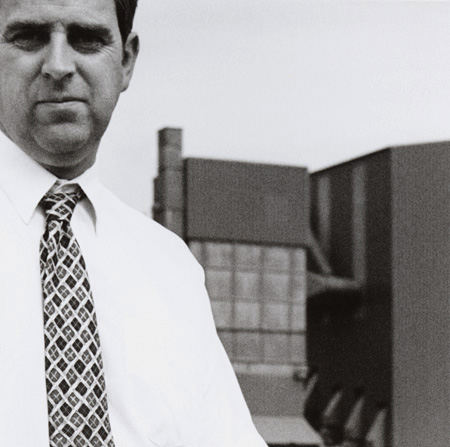| The
stone we quarry here is basalt – known locally as dhustone, from
the Welsh word dhu meaning black. It is exactly the same stone
as was taken out of the old quarries at the top of Titterstone last
century.
The quarry is surrounded by common land, and before we blast we set
sentries on the perimeter to make sure the area is clear. At present,
touch wood, we haven’t had any problems with people straying in
when we are about to fire.
At other times we get the occasional walker. There is a public bridleway
that comes off the main road, runs down the back of the coating plant
and out to Titterstone summit, and people do have a tendency to get
lost. I have to go flying into the quarry once in a while, to tell people
to pop back over the fence because they are close to being pulverised.
Unfortunately all the ‘Keep Out’ signs are wrecked. People
like shooting them with air rifles.
Quarrying is a dangerous industry, but nowadays we try and minimise
the number of accidents. The last accident here was about four years
ago – someone slipped and twisted his ankle. It was very
different last century. They used to scale down the faces on ropes and
lever the stone off with crowbars, and the quarry face would be a sheer
drop of 60 metres.
Mechanisation has changed everything. If you go back to 1900, there
were 2,000 men working on Titterstone Clee and they produced over 400,000
tonnes a year. Today, I’ve got just 18 men and we produce 325,000
tonnes. Our stone is used mainly in construction – foundations,
that sort of thing. A proportion goes into tarmac. It's a very hard,
very abrasive stone. Its main value is that it doesn't break down at
all.
Our current planning authorisation is valid until 2048, and there are
basalt reserves here to take us up to that point at the current production
rate, and beyond. But there are limits. The hill is not all made of
basalt. The basalt is extruded through the overlying limestone and sandstone
and is really only in one area of the hill.
The Clee Hill commoners have grazing rights around the quarry and they
are entitled to come in to gather up their sheep. We have no problem
with that, but they have to abide by the health and safety legislation.
They have to come to reception to make themselves known, and wear hard
hats and high visibility clothing. The commoners understand that –
or at least most of them do.
The only problem we occasionally have is people fishing in the old flooded
quarry within our perimeter. The water gets very deep in there, and
there is no suitable standing point around the edge. If they fall in,
there is no easy way out. God help them if they get on the western side
because there's a 30 metre face.
We are getting more and more dumped cars down here. Whenever we find
one, we contact the police. The strange thing is, these cars are rarely
reported stolen. When the police contact the last owner, he usually
says he sold it to someone in a pub two weeks ago. Unfortunately you
can’t leave these cars lying around. Oils, petrols, burnt rubber,
burnt materials – it's all hazardous waste. We have to dispose
of them at our own cost. It's annoying.
The hill is quite unreal in some respects. It’s in its own little
micro-world. Everybody knows everybody else. The majority of people
in Clee Hill village today had parents and grandparents who lived here,
and many of them would have worked in the quarries in the 19th and 20th
centuries.
Because there were so many people who used to work here, Clee Hill had
its own little community. If there were 2,000 men working in the quarries,
think how many families used to be here. A lot of these people migrated
from Ireland, Wales and all over Britain. So the village always had
a very strong sense of community and it seems to have retained that.
The rest of South Shropshire is very rural, just farming. Clee Hill
really stands apart.
|
